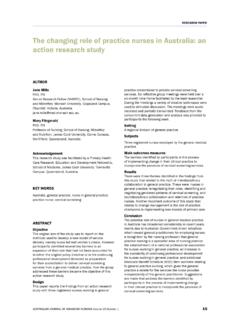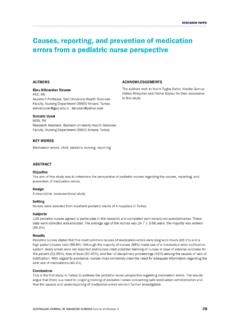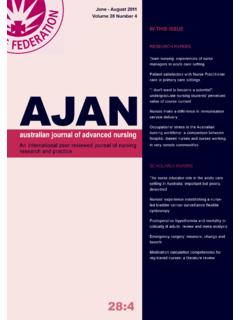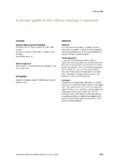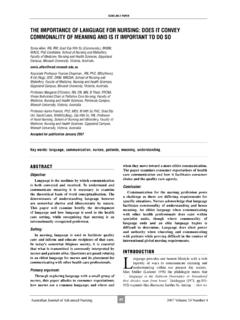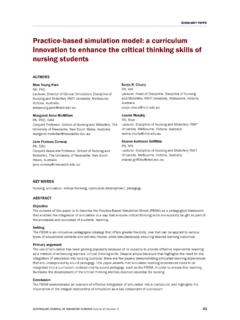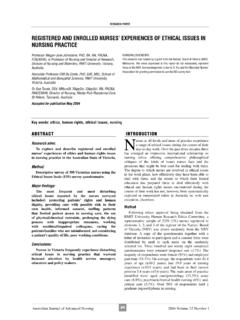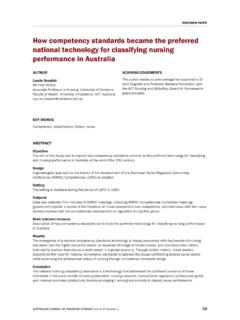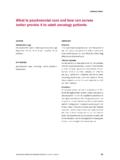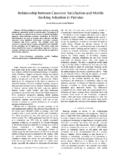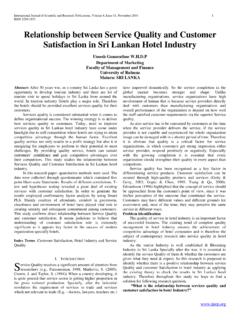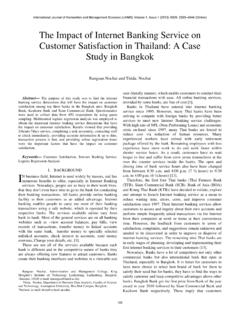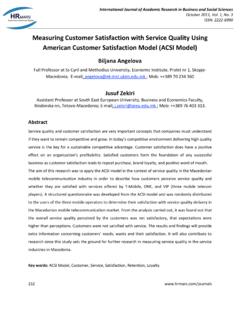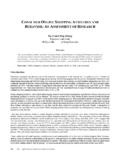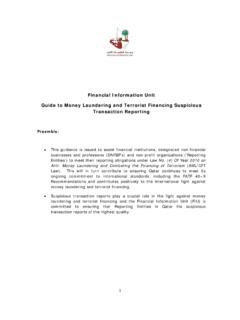Transcription of UTILIZATION OF KINGÕS INTERACTING SYSTEMS …
1 44 Australian Journal of Advanced Nursing 2006 Volume 24 Number 2 ABSTRACTB ackground: The critical role of research in nursing practice isthe application of nursing theories to discover newknowledge. This study uses king s INTERACTING systemsframework and theory of goal attainment toinvestigate the effectiveness of implementing clinicalpathways for patients undergoing transurethralresection of prostate (TURP) at Aga Khan UniversityHospital (AKUH), : To assess the impact of the implementation of aclinical pathway for the surgical procedure of TURPon clinical quality, cost, and patient and Design: Quasi-experimental, non-equivalent control groupstudy design using clinical pathway : Aga Khan University Hospital (AKUH).Subjects: The study population consisted of a conveniencesample of patients undergoing surgery for TURP(control and experimental) and health team members(nurses, physicians and others).
2 Study Findings: Findings showed a significant difference invariances and outcomes as a result of TURP clinicalpathway clinical pathwaysignificantly improved all twelve nursing andphysician related variances and outcomes, such as:complete documentation; delayed consultation;delayed education; and other variances. Clinicalpathway intervention also significantly reducedhospital related variances,and post-operativeproblems such as electrolyte imbalance, phlebitis,constipation, and urinary tract infection (UTI). Thefindings also showed significant improvement inpatient and staff satisfaction, however no significantdifference was observed in patient, hospital andfinancial related current investigation identified that successfulimplementation of integrated clinical pathways can help health professionals,managers andadministrators to meet one of their biggest challengesin making optimal use of limited resources whiledelivering high quality and timely TO king STHEORETICAL SYSTEMSKing first published her conceptual framework in1971 and further developed it into the theory ofgoal attainment in 1981 (Johson and Webber2001).
3 king s SYSTEMS framework is based on theassumption that human beings are the focus of goal of nursing is health: its promotion, maintenance,and/or restoration; the care of the sick or injured; and thecare of the dying ( king 1992). Husting (1997) stated: king s theory evolved from the General SYSTEMS Theoryof Von Bertalanffly. The components of a system theoryare: (a) goal; (b) structure; (c) functions; (d) resources;and (e) decision making ( ). king (1996) furtherstated that the nursing domain involves human beings,families, and communities as a framework within whichnurses make transactions in multiple environments withhealth as a goal (Norris and Frey 2001). HISTORICAL DEVELOPMENT OF king STHEORETICAL SYSTEMSKing (1964) spoke of the need to focus on andorganise existing knowledge in nursing, as well as expandthe knowledge base for nursing practice.
4 She identifiedconcepts of social SYSTEMS , health, interpersonalDr. Khurshid Khowaja, PhD, BScN, RN, RM, Director, NursingServices (AKUH) and Associate Professor School of Nursing,Aga Khan University, Karachi, for publication March 2006 UTILIZATION OF king S INTERACTING SYSTEMS FRAMEWORK AND THEORY OF GOAL ATTAINMENT WITH NEW MULTIDISCIPLINARYMODEL: CLINICAL PATHWAYRESEARCH PAPERKey words: TURP, clinical pathway, multidisciplinary, theory, nursing researchAustralian Journal of Advanced Nursing 2006 Volume 24 Number 2relationships and perceptions as universal to the disciplineof nursing ( king 1995; 1968).In 1971, king published a conceptual framework fornursing organised around personal, interpersonal andsocial SYSTEMS . The concepts were expanded to includecommunication, interpersonal relationships, information,energy, social organisations, role and status. A moreformalised framework by king was published in 1978, king stated that nursing needed to bepromoted as a science, and that the relationship betweennursing and research should be seen as a way to buildscientific knowledge.
5 king (1981) introduced a theory of goal attainment, amiddle-range theory derived from the conceptual concepts in the theory of goal attainment areperception, communication, interaction, transaction, self,role, growth and development, stressors/stress, time andspace. The concepts of interaction, transaction, andperception form the core of a transactions process are critical antecedents to goal is one of the few theorists to generate both aconceptual system and a middle-range theory for there have been few changes to theconceptual system or theory of goal attainment since1981, king and others have provided ongoing discussionand clarification of these theoretical and philosophicalpositions through debates in nursing journals andpresentations ( king 1988, 1989, 1990, 1991, 1992, 1995,1997, 1999, 2000; Norris and Frey 2001).
6 Changes to theconceptual system include: the addition of the concept ofthe personal system ; spirituality as a basic aspect ofhuman beings; and the request to use the term conceptualsystem rather than conceptual framework or paradigm( king 1997). Recently, king further discussed herperspective of the philosophy of human beings and thetheory of goal attainment ( king 1997).RATIONALE OF THE STUDYThe primary focus of this investigation was to assessthe impact of clinical pathways on clinical quality, cost,and patient and staff satisfaction. Clinical pathways use amultidisciplinary approach to the delivery of patient care;therefore the researcher saw the value of testing thisconcept of patient care in her work setting and, in the eventof supportive findings, changing the model of nursingpractice at Aga Khan University Hospital (AKUH) fromthe traditional to the multidisciplinary most significant gap in the literature was theabsence of any Asia-specific research studies conductedby clinical nurses and exploring the role of clinicalpathways in improving clinical quality, patient and staffsatisfaction.
7 An obvious omission in the literature was anytesting of these concepts in other Asian hospitals, or anyapplication of nursing theories as a conceptual frameworkto test this concept. This study applied and tested king stheory of goal attainment to assess the benefits of TURP clinical REVIEW The literature outlines several benefits of clinicalpathways. Chang Gung Memorial Hospital used 18clinical pathways for urological procedures on 1,784patients. The length of stay (LOS) reduced significantlyby 11% (from to days); admission charges ; and average hospital charges decreasedsignificantly by (Chang et al 1999).John (2003) stated that clinical pathwayimplementation saved US$ million in costs frommedical operations over six years in the Children sHospital, San Diego, United States of America.
8 Healy(2002) reported that clinical pathway implementation forknee implant standardisation reduced LOS from daysto days and hospital costs by 19%. Calhoun (2000) inher cohort study found a statistically significantdifference in LOS with the use of clinical pathways forwomen having a vaginal delivery, resulting in costreductions from US$ million to $ million. Healy(2002) found that a clinical pathway and kneestandardisation program in reduced average LOS days in 1992 to days in and Provenzano (1995) found thatimplementation of a clinical pathway reduced averageLOS for patients from to days and achieved perpatient cost savings of US$3,100. Kevin et al (2000)reported that using clinical pathways for asthmamanagement decreased the beta-agonist medication usefor inpatients with quasi-experimental design with non-equivalentgroups was used to answer the research questions,objectives and hypotheses.
9 The target population was allpatients requiring TURP in Pakistan. The accessiblepopulation was those patients admitted to AKUH forTURP, resulting in a convenience inclusion criteria were: patients who wereconsidered by the urology surgeon and anaesthetist to befit for TURP. The exclusion criteria were patients who hadundergone emergency TURP and patients having multiplesurgical procedures with several current investigation also collected data from 1 August 2000 to 31 December 2002 from the health careteam members who were involved in the direct care ofpatients with TURP. They included nurses, physicians,dietitians, pharmacists, and researcher used a power analysis procedure toestimate a sample size of 200 patients to achieve theresearch objectives. Statistical power was determined bythree factors - (a) alpha: the criterion for significance wasRESEARCH PAPER45 Australian Journal of Advanced Nursing 2006 Volume 24 Number 2set at ; (b) effect size: the estimate of the meandifference between the populations was set at a 95%confidence level to account for sampling error at ona 2 to +2 scale; and (c) sample size: calculated as 100for each of two groups to give a statistical power of 88%to yield a statistically significant result, which isacceptable to most authorities (Heiman, 1992).
10 Written approval to conduct study was obtained from theHuman Ethics and Research Committee of the University ofBallarat in Australia. In addition approval was also obtainedfrom the Ethical Review Committee of validity and reliability of outcome related instrumentsConstruct validity was used for instruments of processand outcome measurement, which were variance-trackinginstruments and the clinical pathway. For variancetracking instruments, content validity was also used as itcontained all the important aspects of patient care. Thisinstrument consisted of 57 items out of which 35 itemswere related to variances in patient care, 11 items relatedto monitoring clinical indicators, and 11 items related tomonitoring financial variances. Face and content validity was used for satisfactionsurveys as formal validation of measuring survey questionnaires had content validity as theycontained all-important components of patient and staffsatisfaction such as: medical care, information and caring,promptness of service, courtesy of service providers, andcomfort amenities provided.
